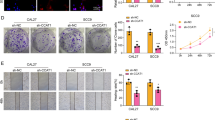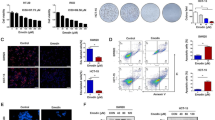Abstract
Zinc deficiency was implicated in the etiologies of human esophageal squamous cell carcinoma (ESCC). Wild-type p53-induced gene 1 (WIG-1), a kind of zinc finger protein, was cloned from the human 3q26.3 region and encoded a putative polypeptide of 289 amino acids. Our previous studies have demonstrated that the expression of WIG-1 was downregulated in ESCC tissues. Herein, we investigated the effect of zinc on cell proliferation, apoptosis, as well as expression of WIG-1 in EC109 cells. Meanwhile, an RNAi vector of WIG-1 was transfected into EC109 cells and the effect of zinc on WIG-1 expression was investigated. We found that zinc could suppress cell proliferation and induce G0/G1 cell cycle arrest and apoptosis of EC109, and this efficacy might result from the expression altering of several apoptosis-related genes, such as Bax, p21 WAF, and cyclin D1. In particular, upregulation of WIG-1 was observed after zinc supplementation, indicating that WIG-1 might be involved in the zinc-induced cell cycle arrest and apoptosis of EC109 cells by regulating the expression of Bax, p21 WAF, and cyclin D1.




Similar content being viewed by others
References
Berg JM, Shi Y. The galvanization of biology: a growing appreciation for the roles of zinc. Science. 1996;271:1081–5. doi:10.1126/science.271.5252.1081.
Sky-Peck HH. Trace metals and neoplasia. Clin Physiol Biochem. 1986;4:99–111.
van Rensburg SJ. Epidemiologic and dietary evidence for a specific nutritional predisposition to esophageal cancer. J Natl Cancer Inst. 1981;67:243–51.
Fong LY, Sivak A, Newberne PM. Zinc deficiency and methylbenzylnitrosamine-induced esophageal cancer in rats. J Natl Cancer Inst. 1978;61:145–50.
Fong LY, Li JX, Farber JL, Magee PN. Cell proliferation and esophageal carcinogenesis in the zinc-deficient rat. Carcinogenesis. 1996;17:1841–8. doi:10.1093/carcin/17.9.1841.
Fong LY, Ishii H, Nguyen VT, Vecchione A, Farber JL, Croce CM, et al. p53 deficiency accelerates induction and progression of esophageal and forestomach tumors in zinc-deficient mice. Cancer Res. 2003;63:186–95.
Lipman TO, Diamond A, Mellow MH, Patterson KY. Esophageal zinc content in human squamous esophageal cancer. J Am Coll Nutr. 1987;6:41–6.
Kumar A, Chatopadhyay T, Raziuddin M, Ralhan R. Discovery of deregulation of zinc homeostasis and its associated genes in esophageal squamous cell carcinoma using cDNA microarray. Int J Cancer. 2007;120:230–42. doi:10.1002/ijc.22246.
Abnet CC, Lai B, Qiao YL, Vogt S, Luo XM, Taylor PR, et al. Zinc concentration in esophageal biopsy specimens measured by X-ray fluorescence and esophageal cancer risk. J Natl Cancer Inst. 2005;97:301–6. doi:10.1093/jnci/dji042.
Zou YB, Guo W, Jiang YG, Wang RW, Zhao YP, Ma Z. Preparation of a novel monoclonal antibody specific for WIG-1 and detection of its expression pattern in human esophageal carcinoma. Hybridoma (Larchmt). 2010;29:431–6. doi:10.1089/hyb.2010.0043.
Oka M, Hirazawa K, Yamamoto K, Iizuka N, Hazama S, Suzuki T, et al. Induction of Fas-mediated apoptosis on circulating lymphocytes by surgical stress. Ann Surg. 1996;223:434–40.
Jemal A, Siegel R, Ward E, Hao Y, Xu J, Murray T, et al. Cancer statistics, 2008. CA Cancer J Clin. 2008;58:71–96. doi:10.3322/CA.2007.0010.
Enzinger PC, Mayer RJ. Esophageal cancer. N Engl J Med. 2003;349:2241–52.
Puca R, Nardinocchi L, Bossi G, Sacchi A, Rechavi G, Givol D, et al. Restoring wtp53 activity in HIPK2 depleted MCF7 cells by modulating metallothionein and zinc. Exp Cell Res. 2009;315:67–75. doi:10.1016/j.yexcr.2008.10.018.
Varmeh-Ziaie S, Okan I, Wang Y, Magnusson KP, Warthoe P, Strauss M, et al. WIG-1, a new p53-induced gene encoding a zinc finger protein. Oncogene. 1997;15:2699–704.
Hellborg F, Qian W, Mendez-Vidal C, Asker C, Kost-Alimova M, Wilhelm M, et al. Human WIG-1, a p53 target gene that encodes a growth inhibitory zinc finger protein. Oncogene. 2001;20:5466–74.
Israeli D, Tessler E, Haupt Y, Elkeles A, Wilder S, Amson R, et al. A novel p53-inducible gene, PAG608, encodes a nuclear zinc finger protein whose overexpression promotes apoptosis. EMBO J. 1997;16:4384–92.
Vilborg A, Glahder JA, Wilhelm MT, Bersani C, Corcoran M, Mahmoudi S, et al. The p53 target WIG-1 regulates p53 mRNA stability through an AU-rich element. Proc Natl Acad Sci USA. 2009;106:15756–61. doi:10.1073/pnas.0900862106.
Varmeh-Ziaie S, Ichimura K, Yang F, Rabbits P, Collins VP. Cloning and chromosomal localization of human WIG-1/PAG608 and demonstration of amplification with increased expression in primary squamous cell carcinoma of the lung. Cancer Lett. 2001;174:179–87. doi:10.1016/S0304-3835(01)00699-1.
Enge M, Bao W, Hedstrom E, Jackson SP, Moumen A, Selivanova G. MDM2-dependent downregulation of p21 and hnRNP K provides a switch between apoptosis and growth arrest induced by pharmacologically activated p53. Cancer Cell. 2009;15:171–83. doi:10.1016/j.ccr.2009.01.019.
Vilborg A, Bersani C, Wilhelm MT, Wiman KG. The p53 target WIG-1: a regulator of mRNA stability and stem cell fate? Cell Death Differ 2011 (in press)
Brass N, Rácz A, Heckel D, Remberger K, Sybrecht GW, Meese EU. Amplification of the genes BCHE and SLC2A2 in 40% of squamous cell carcinoma of the lung. Cancer Res. 1997;57:2290–4.
Sattler HP, Lensch R, Rohde V, Zimmer E, Meese E, Bonkhoff H, et al. Novel amplification unit at chromosome 3q25–q27 in human prostate cancer. Prostate. 2000;45:207–15.
Lazo PA. The molecular genetics of cervical carcinoma. Br J Cancer. 1999;80:2008–18. doi:10.1038/sj.bjc.6690635.
Hibi K, Trink B, Patturajan M, Westra WH, Caballero OL, Hill DE, et al. AIS is an oncogene amplified in squamous cell carcinoma. Proc Natl Acad Sci USA. 2000;97:5462–7. doi:10.1073/pnas.97.10.5462.
Sugita M, Tanaka N, Davidson S, Sekiya S, Varella-Garcia M, West J, et al. Molecular definition of a small amplification domain within 3q26 in tumors of cervix, ovary, and lung. Cancer Genet Cytogenet. 2000;117:9–18. doi:10.1016/S0165-4608(99)00135-1.
Imoto I, Yuki Y, Sonoda I, Ito T, Shimada Y, Imamura M, et al. Identification of ZASC1 encoding a Krüppel-like zinc finger protein as a novel target for 3q26 amplification in esophageal squamous cell carcinomas. Cancer Res. 2003;63:5691–6.
Resnitzky D, Gossen M, Bujard H, Reed SI. Acceleration of the G1/S phase transition by expression of cyclins D1 and E with an inducible system. Mol Cell Biol. 1994;14:1669–79.
Zhang H, Hannon GJ, Beach D. p21-containing cyclin kinases exist in both active and inactive states. Genes Dev. 1994;8:1750–8. doi:10.1101/gad.8.15.1750.
Harper JW, Adami GR, Wei N, Keyomarsi K, Elledge SJ. The p21 Cdk-interacting protein Cip1 is a potent inhibitor of G1 cyclin-dependent kinases. Cell. 1993;75:805–16. doi:10.1016/0092-8674(93)90499-G.
Zeng YX, El-Deiry WS. Regulation of p21WAF1/CIP1 expression by p53-independent pathways. Oncogene. 1996;12:1557–64.
Shao ZM, Dawson MI, Li XS, Rishi AK, Sheikh MS, Han QX, et al. p53 independent G0/G1 arrest and apoptosis induced by a novel retinoid in human breast cancer cells. Oncogene. 1995;11:493–504.
Reed JC. Dysregulation of apoptosis in cancer. J Clin Oncol. 1999;17:2941–53.
Fong LY, Nguyen VT, Farber JL. Esophageal cancer prevention in zinc-deficient rats: rapid induction of apoptosis by replenishing zinc. J Natl Cancer Inst. 2001;93:1525–33. doi:10.1093/jnci/93.20.1525.
Acknowledgments
This work was supported by the National Natural Science Foundation of China (No. 30801137 and 81071976).
Conflicts of interest
None.
Author information
Authors and Affiliations
Corresponding author
Additional information
Wei Guo and Ying-Bo Zou contributed equally to this study.
Rights and permissions
About this article
Cite this article
Guo, W., Zou, YB., Jiang, YG. et al. Zinc induces cell cycle arrest and apoptosis by upregulation of WIG-1 in esophageal squamous cancer cell line EC109. Tumor Biol. 32, 801–808 (2011). https://doi.org/10.1007/s13277-011-0182-5
Received:
Accepted:
Published:
Issue Date:
DOI: https://doi.org/10.1007/s13277-011-0182-5




